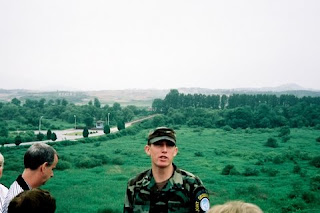A very early start to get to the USO by 7:10 am for our tour. Two busloads of white faces heading to P’anmunjom and the DMZ. Dress code was very strict- no sneakers, no sandals, no jeans, no shorts, no short skirts, no sleeveless tops. The North Koreans evidently take photos of scantily or poorly clad tourists and use them as propaganda to point out the loose morals of the west.
Our tour started with a visit to Camp Bonifas, the advance camp for P’anmunjom. We got a briefing from an American corporal from the MAC (Military Armistice Commission). We were required to sign a release of liability, got a visitors badge and headed to the DMZ.
The Demilitarized Zone (DMZ) stretches for 241 km, and was established at the end of the Korean War. Placed at regular intervals down the entire centerline were 1,292 white markers holding signs that indicate the actual borderline, the Military Demarcation Line (MDL). The zone is a no-mans’ land- barbed wire fences with guard posts at regular intervals. 
There is only one village within the southern half of the DMZ, called Freedom Village (Taesong-dong). It is a tiny farming community of 236 people. Villagers are exempt from taxes and conscription and earn a healthy $82K a year (tax free!) They farm an average of 17 acres. They do have to spend a minimum of 240 days in the village and have to be in the village by dark.
Straddling the actual border area near the west end of the DMZ is the Joint Security Area (JSA), known as P’anmunjom. It’s less than one square kilometer in size and is the only place where mutually agreed upon contact between the UN and North Korean military representatives takes place.


We were escorted to a two- story pavilion overlooking the blue and silver building in the center of the compound, used for MAC meetings.
Beyond that is North Korea’s most prominent building. P’anmun-gak is a three story building with huge windows on the upper floors…and it is only 6 meters deep. You can look directly at the North Korean guards- who are looking right back and taking pictures.
The MDL runs through the center of the building and through the central table. When going around the table, you actually enter North Korea. It was quite dramatic- with ROK (Republic of Korea) soldiers standing in ty-kwan-do position by the table.

From the observation post next to the building, you can see “Propaganda Village”, North Korea’s only village within the DMZ. There are a number of new high-rise apartment buildings in the village- but we were told that no one lives there. Maintenance personnel and farmers are bused in from Kaesong and bused back in the evening. In the center of the village is a 160-meter tall flagpole (built to be taller than the flagpole in the South Korean village).
We drove past Checkpoint 3- “the loneliest guard post in Korea”.
It sits at the south end of the Bridge of No Return (the bridge crossed by the crew of the USS Pueblo in 1968). In 1976, there was an “ax-murder” incident at the foot of the bridge when North Korean troops attacked American and South Korean troops as they tried to cut down a large tree. Two Americans were killed in the attack.
Lunch was back at Camp Bonifas and we got to visit the Officers Club (“The Monastery- Home of the Merry Monks of the DMZ”).

After a buffet lunch, we headed for the Third Tunnel of Aggression. The tunnel, discovered in 1978, was started in the northern half of the DMZ and dug into the southern half before its discovery. It is 150 feet below ground, about 2 meters tall and two meters wide. According to estimates, it was large enough to carry a full division of fully equipped North Korean troops per hour. An interception tunnel has been dug to meet this tunnel (which was never completed).
There is a long descent on slippery, wet rubber matting down to the original tunnel. Once in the tunnel, you can walk another ½ km to the point just below the MDL where a military guard post has been created. The walk back up the slippery slope was quite a challenge (we stopped at what we dubbed, “The Western Rest Areas”) (none of the Asians appeared to need the rest stops, but they were filled with Caucasians).
One last stop in the DMZ was at an Observation Building and we had a short briefing. Unfortunately, the skies were cloudy and we couldn’t see much of North Korea.
We headed back for Seoul and dumped the group in downtown Seoul We walked by the Hotel Lotte, the largest hotel in Seoul and were shocked to see about 3000 riot control police lining the subway staircases, the hotel driveway and roof. They were outfitted with riot shields, batons and helmets and in military formation. It turns out that they were getting ready for a pre-dawn move on a group of protesting unionist doctors.
Rather than stay around for the action, we headed for the Westin and found the only Korean-Irish bar in town, O’Kim’s. Too expensive wine and lasagna- but it was worth every cent. Sometimes you just need to feel that you’re not in Asia anymore.




No comments:
Post a Comment